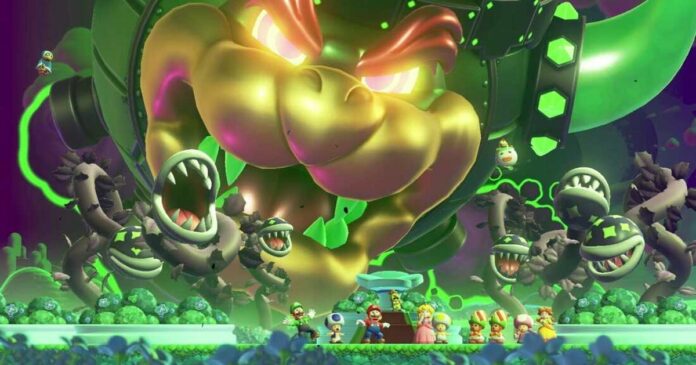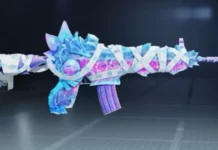It’s not often we get to hear a senior developer of a Super Mario Bros. game philosophise about game design. At gamescom last year, Takashi Tezuka, executive officer at Nintendo and producer on Super Mario Bros. Wonder, and Shiro Mouri, the game’s director, gave us a glimpse, as they spoke with Eurogamer about their intentions for Super Mario Bros. Wonder.
At the time, Tezuka said “There was a lot of feeling about creating something else, something new,” with Mouri adding that “in terms of the concept for creating a new Mario, we came up with the concept of mystery and secrets”.
Much of that was echoed by the pair’s talk at GDC last week: Tezuka noted the team’s mantra this time was “Big Changes,” while Mouri mentioned the sense of lingering familiarity again, and the desire to evolve things in light of it. Only this time they opened up a little further, offering detail on cut ideas, development approaches and more – but they began with the same point they made to us.
“In the first Super Mario Bros., points came out when you hit blocks, and you grew bigger when you got a Super Mushroom. Everything about it was new, and full of secrets and mysteries. However, as 2D Mario has been played for many years, at some point all of this has become normal,” Mouri said.
“Therefore, on the latest game, I tried making a new version of these secrets and mysteries. I tried making something where if you hit a block, a special item comes out, and if you take this item, you can go to another area. When I showed that to Mr. Tezuka, he said, “This isn’t so different to how it’s always been. Can’t you make this so instead of going to another area, the environment itself changes?”
“So I thought, “Well, if I’m going to change the environment anyway, I might as well go hard.” I made constant changes that have never been seen in a Super Mario Bros. title. I made the Warp Pipes wiggle and the Piranha Plants break out in song. And so, this is how the strange changes that happened – the Wonder Effects in this game – came to be.”
Tezuka, meanwhile, opened with a discussion of Super Mario Maker, joking to the audience that while everyone had a “level playing field” in terms of enemies and tools available, “when we played the posted courses – and let’s keep this here – some of them were not very good!”
The real lesson, he said, was that while good controls, enemy design, and so on were important, “whether they come alive or fall flat is dependent on the level designer.”
“What goes through my mind when creating a Mario game,” he continued, is that “the presentation of games has evolved over time, as images and sounds can now be produced to look and sound more real. But how has realism in gameplay evolved?” For example, he said, “Does Mario feel pain when he hits an enemy? Does he get antsy when he’s moving around high places – does he become more cautious when his heart’s thumping with excitement? Don’t you feel that if players feel that way, they will be able to immerse themselves more in the game?”
Answering his rhetorical questions, Tezuka continued, “If anything, I think it’s important for the gameplay experience to feel real – but I don’t think we should seek a sense of accomplishment based only on the realness of the presentation. For example, we should think about whether there are ways to make the gameplay realistic, even if the presentation itself is not. Even if expressive character movements and sounds are produced, what’s important is how we make use of them.”
This led Tezuka on to a discussion of team management, something that, he said, has become “even more important” in recent years – and which eventually led to the developers’ explanation of how roughly 2000 ideas were generated for Super Mario Bros. Wonder’s transformational Wonder Effects, and how those ideas were narrowed down. “As hardware has evolved, the size of development teams has increased in proportion to the scale of game production. And something we didn’t focus on during the NES days, which was team management, is now an important job,” as was “getting lots of people working in the same direction, to develop a game with as little waste as possible.”
The answer, for Nintendo, lay in thinking about “how we can represent each person’s individuality and strengths in production,” which led to Mouri’s approach to brainstorming.
“We held brainstorming sessions where the whole team shared their ideas for Wonder Effects,” Mouri explained. “It was up to everyone on our team to come up with ideas, regardless of job title or seniority; Nintendo believes that everyone on a team is a game designer. At first, we asked everyone to write any and all ideas on sticky notes, without any conditions. After all, if you start with conditions, you stifle creative freedom. At this stage, we collected around 2000 ideas.”
The team then began narrowing down the ideas by thinking about specific criteria that made for good Wonder Effects. The first was “a connection between pre-Wonder Effect and during the Wonder Effect.” The example given was an idea that you suddenly transform into Balloon Mario – “that would feel unnatural” on its own, Mouri said. “However, by having balloon-esque enemies appear first, then having the player transform into Balloon Mario during a Wonder Effect, the feeling of unnaturalness is removed.”
The other criteria included the notion of “having players suddenly be able to do something they couldn’t before,” and “having it be explained simply with one short phrase”. With pitches in hand and criteria on what made for a good one settled, the studio moved on to the “testing phase”.
“This testing phase was also conducted by everyone on the team,” Mouri explained. “Each testing team was comprised of one game designer, one artist, one programmer, and one sound engineer. When necessary, we created new temporary design data and sound data. Once the testing phase was over, all team members would play the prototype, then share their opinions. In response to these opinions, team members would share and layer [on] even more ideas, and this eventually led to the product version taking shape.”
Mouri said “more than half” of the ideas that made it to the prototype phase didn’t make it to the final game, “but these testing sessions had many effects… everyone gained development experience; everyone’s motivation increased; and the team’s solidarity improved. And more importantly: coming up with prototypes is just fun!”
Perhaps the juiciest part of the talk then followed, as Mouri highlighted Wonder Effects that made it into the game and how they changed, such as the effect where “the terrain tilts”, and the comical non-sequitur of an idea in wonder quizzes. “This is an idea that came from a programmer in his first year at the company,” Mouri said. “At Nintendo, even first year employees and programmers pitch in ideas. And if those ideas are good, of course they’re adopted! All he did,” Mouri joked, “was write: ‘A wonder quiz starts’ on a sticky note. Without any more specific info! Do you think we can call this a good idea?!
“When I saw this, I thought to myself: ‘This idea has potential!’ What I saw was the opportunity to create a unique Wonder Effect where Mario takes the opportunity to answer questions; a way to supplement the world theme of the game; and motivation for players to play multiple times to see all the questions.”
“I don’t think this is an idea that I would have ever come up with,” Tezuka added, “and I believe this is what’s interesting about creating play with other people.”
As for the effects that failed to make it into the final game, one involved giving Mario a giant head made of blocks, and you having to evade Gnawshers, the enemies that like to eat them. “We felt like it had a very strong and interesting visual appeal, so we tried prototyping it,” Mouri said, showing an example of the enjoyably ridiculous prototype in action, but the issue was “the area of the blocks is large, and it was impossible to develop a strategy of how to avoid enemies, so it just turned into a game of making a mad dash for the end. However, reducing the area of the blocks would have resulted in losing that visual appeal, so we decided to not use it.”
The second was a faintly horrifying pitch from the game’s sound director, Koji Kondo.
“His idea was, when a Wonder Effect activates, a live action version of Mario with human proportions appears, starts progressing along a stage while humming the background music, and mimicking the various sound effects himself. As an idea, it’s very funny, but it’s hard to see the connection between pre-Wonder Effect and Wonder Effect, and it’s hard to imagine the gameplay changing much by having Mario turn into a live-action human-proportion version of himself.”
In the end, the team enjoyed it too much to see it go to waste – with “mottainai”, the sense of frustration at not making the most of an opportunity, another theme of the studio’s talk. “It was such an interesting idea, it would’ve been mottainai to not use it.” And so, the Sound Off badge came to be – a modifier where equipping the badge replaces all of the game’s music and sounds with a single person’s attempt at imitating them verbally.
“The appeal of this badge is it makes you want to try out various actions to hear all the sound effects,” Mouri said. “Incidentally, the man behind the voice of the Sound Off badge is… Mr Kondo himself, the one who pitched this idea.”
Much of Nintendo’s talk came back to a few points of sage advice – on everything from overall design philosophy, to managing teams, or the advantages of 2D development over more flexible 3D worlds.
2D Mario, for instance, had the advantage of allowing the developers to spend much more time than usual tinkering with levels and gameplay specifically. “In 2D Mario games, you spend as much time as possible adjusting courses until the end of development,” Tezuka explained, a process Mouri referred to as “creating while running.”
At the same time, 2D Mario games typically offered players “limited choice,” which is part of what led to the introduction of Wonder’s regularly swappable badge system and free-roam overworld map. Online play in Wonder was designed to be “a system where you naturally want to say thank you to other players,” as an answer to challenges like getting frustrated when losing in PvP, slower players holding things up in co-op, and “players with poor online etiquette” ruining the vibe. The first properly-voiced characters in 2D Mario, meanwhile – the plants that cheer you on as you go – were born of a belief that “players wanted to feel praised,” but more often than the clapping sounds that triggered in previous games.
Above all however, was this notion of wasted opportunity, “mottainai”. Tezuka gave the best example of this in Super Mario Bros. Wonder’s terms, echoing a very similar approach to the one detailed by The Legend of Zelda: Tears of the Kingdom’s developers earlier that day. “I recommend that art and sound teams, as well as the entire team, share what they were thinking when they were working,” he said.
“For example, in Super Mario Bros Wonder, we created this cute animation for when two Koopa Troopa bump into each other while walking – but if work on course design is done without anyone noticing it, it’s possible we might not see this charming interaction happen very often.
“When thinking about course design,” the team realised, “it would be ideal to consider how to create scenes where Koopa Troopa collide, so that the sound staff would then want to create the perfect sound effect for that happening.”
“We noted that there are many ways to create games,” Tezuka concluded, “but the first thing we think deeply about is: what will become the ‘core’ of the game. I get very worried about production if I can’t imagine what’s going to be the fun of the game, before we start polishing the graphics, sound and on-screen presentation.
“If we proceed without that understanding,” he said, “I don’t think anything becomes more interesting as we move forward.”
www.eurogamer.net







